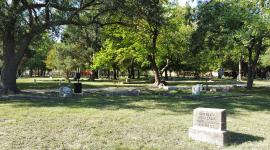Impacts of African Cultures on the American Landscape
From the earliest settlements of non-indigenous peoples in what would eventually become the United States European and African cultural, technological, and social traditions melded, shaping a uniquely American culture. By 1839, 2.3 million (eighteen percent) of the 12.8 million people in the United States were of African descent. Through daily activities and interactions, Africans and their descendants profoundly informed American culture, influencing visual arts, music architecture, foodways, and language. African words, phrases, and names permeate American English, evidenced by places such as Suwanee Old Town, FL, and Nicodemus, KS. African culture similarly influenced how cultural landscapes were shaped and cultivated.
During the period of enslavement, whether with permission or in acts of resistance, African Americans congregated in public spaces to engage in practices and rituals derived from West and Central African antecedents, including dance, instrumentation, song, spirituality, and other forms of cultural expression. Trees and other natural features often stand as living witnesses to collective moments of joy, spirituality, and grief enacted in these public spaces.
Several southern plantations became dependent on people with direct or inherited knowledge of African agricultural practices and technologies. In the eighteenth century people were forcibly taken from rice growing regions of West Africa to cultivate the crop in America. The tidal floodplain system used in the Senegambia region of Africa, for instance, was reproduced on plantations in South Carolina, Georgia, and Louisiana. Knowledge and technologies informed agricultural practices that persist today in Gullah/Geechee culture, which stretches from the Carolinas to northern Florida.
West African funerary practices are also manifest at surviving burial grounds throughout the eastern and southern United States. Such practices include adorning or placing seashells at burial sites and orienting the interred according to the cardinal directions.
<<<Back to the Guide to African American Cultural Landscapes








